![]() 1st Battalion 22nd Infantry
1st Battalion 22nd Infantry ![]()
Operations 1904 - 1905
Part Two
![]()
Campaign Streamer awarded to the 22nd Infantry for its service in Mindanao 1904-1905
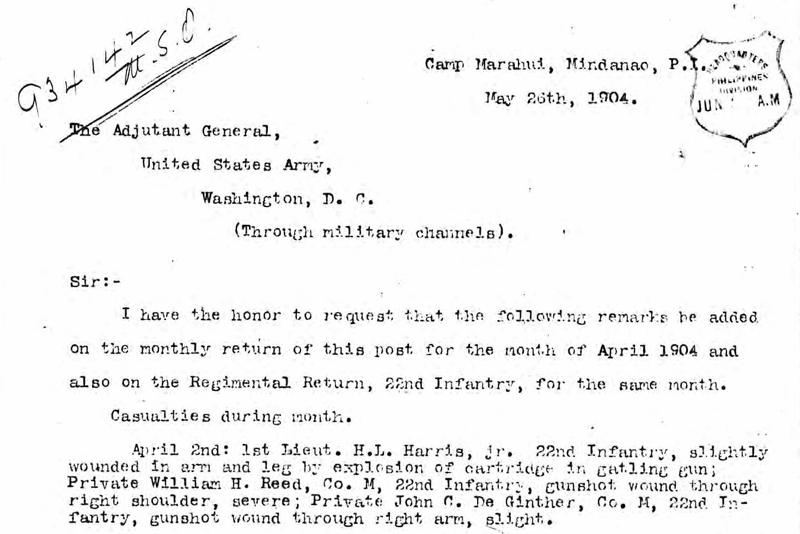
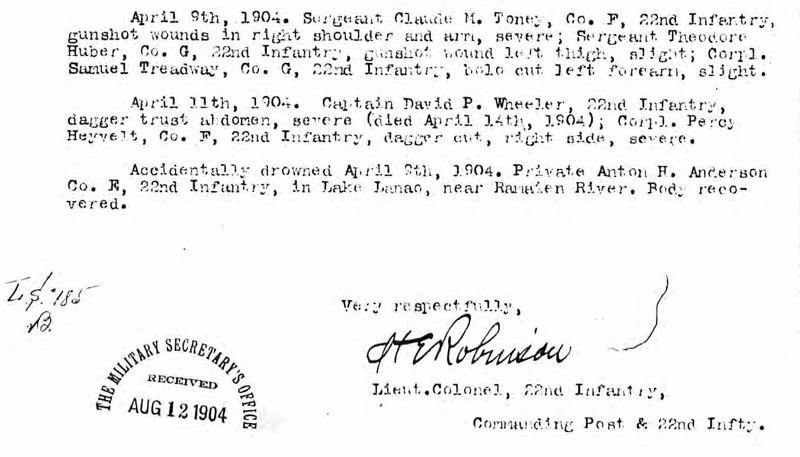
The above report was
attached to the monthly returns Robinson was the Executive
Officer of the 22nd Infantry Robinson was assigned to the
22nd Infantry from April 1904 The Private John C. De Ginther
mentioned in the first paragraph |
Lt. Col. Henry E. Robinson |
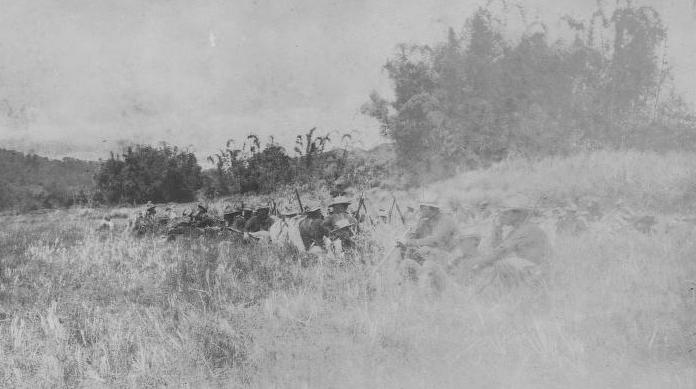
22nd Infantry near Delama
Photo from the Parker Hitt photograph collection, University of Michigan
There were still, however, a great many hostile
Moros in the Taraca region. To pacify them became the duty of the
troops at Camp Wheeler.
Friendly overtures were made; natives were encouraged to return
to their homes and to resume their agriculture. A few of them at
length returned,
but minor sultans and dattos that had not felt American power
exerted bad influences. To allay hostility and to show the Moros
that they
should not be molested so long as they remained peaceful, the
troops made practice marches all over the region. At many places
the troops
were invariably fired upon;* natives lay in hiding near the camp
and reported any unusual preparations being made; cunningly
devised snares
were laid along paths that the companies would use; attempts were
made to lure officers to their deaths. Rains made the eastern
lake country
one great swamp, but still the command marched and worked for the
establishment of peace and order. Frequently companies
were sent from Marahui to cooperate with the Taraca companies.
And slowly but surely American influences extended; Moro firearms
were captured or surrendered; Moros returned to their homes and
again worked in the rice fields.
* Wounded in action at Gandamato, May 10, 1904: Artificer Bruno Heyne, company B.
Meantime, at Marahui, the general condition was
also improving. The necessity of guarding the large post and the
quantities of supplies
prevented frequent expeditions; but once a week troops made
practice marches in the neighborhood of disaffected regions.
On the night of July 10, 1904, a sentinel was cut down *, and his
rifle stolen. The assailants were traced to Marantao. The sultan
of that place
refused to surrender either the stolen rifle or the Moro that had
made the attack. Before daylight on the morning of August 1,
1904,
the Marantao district, extending three miles along the western
shore of the lake, was surrounded. At daybreak the troops were
fired upon.
They immediately attacked the numerous cottas, destroying the
houses, and inflicting severe losses on the enemy.
* Private Benjamin Oswald, company I. Fingers of left hand almost severed; in addition, left knee-cap cut.
Of the many expeditions sent out from Camp
Wheeler, that against Malug is typical of the service required
operating against the Moro.
After the general campaign against Taraca, April 2 to 10, 1904,
the greater part of the Maciu tribe disappeared.
No great casualties had been inflicted upon them, yet thousands
of them were afterward missing. It was not believed that so many
Moros
could live permanently in the mountains; search and inquiry
failed to discover them along the lake shore.
While exploring a trail through a cañon on
August 12, 1904, detachments from companies I and K encountered a
strong cotta,
that completely controlled the trail. It was of formidable
proportions, with walls twenty feet high and a surrounding ditch,
twenty feet in depth,
filled with running water. The trail leading to the entrance was
an incline four feet wide. At the head of this was, apparently, a
great bamboo gate;
to one side of the gate, an entrance that admitted only one man
at a time.
When the troops came in sight of the cotta,
angry Moros on the walls ordered them away. As the troops did not
obey, the Moros opened fire
with rifles and lantacas. Only an overwhelmingly superior force
could have taken this cotta by direct assault; accordingly the
small detachment
endeavored to keep down the fire from the walls while several men
ascended the incline and tried to burn the large gate. On
approaching the gate,
however, it was seen that, behind this gate, which inclined
outward, was a great heap of boulders. The gate was controlled by
a bamboo lever that,
when sprung, would drop the gate outward and hurl down the
incline several tons of rocks. Through slits in the woven bamboo,
Moros were seen
attempting to spring the lever. These Moros were shot down at
once. Several men then started to climb over the gate, while
their comrades
protected them by a covering fire from the outside. Just as they
reached the inside of the cotta, one of them was shot and speared
by concealed Moros.*
* Private John S. Sturm, company I.
Realizing that this cotta could not be taken by
such a small force without great loss, the detachment withdrew.
On the following morning, reinforced by companies L,, M, and F,
from Marahui, the troops again attacked the stronghold and
captured it without loss.
After entering, the large gate was sprung; the cotta was then
examined. It was admirably constructed; well-arranged bomb proofs
had protected the defenders from any possible artillery fire.
Beyond question, it was the strongest cotta that has been
captured in the Lanao district.
The position and size of this fortification was evidence of
something beyond that the Moros were anxious to conceal from the
Americans.
Detachments were promptly sent up the trail. Upon reaching the
crest of the first foothills, the mystery was explained, the
whereabouts
of the Macius discovered. Cottas, cultivated fields, and
thousands of Moros burst upon the sight of the troops. From this
unknown rendezvous,
war was to be continued indefinitely.
On the day following this discovery,
representative Moros appeared at Camp Wheeler and made a proposal
to surrender all firearms.
These negotiations are still pending.
GENERAL ORDERS No. 15.
HEADQUARTERS 22ND U. S.
INF.,
CAMP MARAHUI, MIND., P. I.
August 31st, 1904.
It becomes again, after a
very brief interval, the painful duty of the Regimental Commander
to announce the death of an officer of the regiment:
2nd Lieut. Fitzgerald S. Turton, who died at this post on the
29th instant.
Lieut. Turton had been with the regiment only a few months, but
during that time he had firmly established himself in the
confidence,
respect and esteem of all who knew him. His conduct while a
member of this regiment was characterized by strict attention to
duty and courage,
gallantry and coolness in action.
Lieut. Turton was born in New Zealand, on July 15, 1874. He
entered the U. S. army on April 18, 1900, and served as private,
sergeant,
first sergeant and battalion sergeant major, 16th infantry, until
October 9, 1903, when he was commissioned a second lieutenant
and assigned to the 22nd infantry.
The officers of the regiment will wear the usual badge of
mourning for thirty days.
BY ORDER OF LIEUT. COL.
ROBINSON:
R. L. HAMILTON,
Captain, 22nd Infantry, Adjutant.
The middle of August, a detachment of ninety
men— Captain O. R. Wolfe, commanding—was sent to the
Cottabato district
to operate against Dato Ali. Nine men were selected from each of
the ten companies at Marahui; only the strongest, most active men
were sent.
At the present writing, the command is still in the Cottabato
district. The work they have been called upon to do has taxed the
endurance
of even specially selected men. They have worked unceasingly in
mud and water, at times on short rations.
The Sultan of Oato was numbered among the Moros
professing allegiance to the United States. Accompanied by a
retinue of followers and slaves,
he made frequent ceremonious visits to Marahui. Military
authorities were therefore greatly surprised when, in the latter
part of September,
this Sultan greeted the gunboat Flake with rifle and
cannon fire.
His territory contained three stone cottas, two
of them on commanding hills. The surrounding country was known to
be rough,
and in many places impassable.
On the morning of October 24, 1904, the 2nd
battalion, 22nd infantry, embarked at Marahui and proceeded
toward Oato.
Troop F, 14th cavalry, left Marahui at the same time, moving by
trail, with a view to cover Oato's territory on the north and
west.
A battalion of the 23rd infantry and the 17th field battery had
left Vicars a day earlier to cover the southern and western
borders
of the disaffected country.
The battalion of the 22nd arrived at Oato at
daylight. The Moros promptly opened fire with lantacas and
rifles; under cover of a return fire
from the Flake, two companies were landed in row boats,
and after a hard climb, drove the Moros from minor cottas on the
first hills.
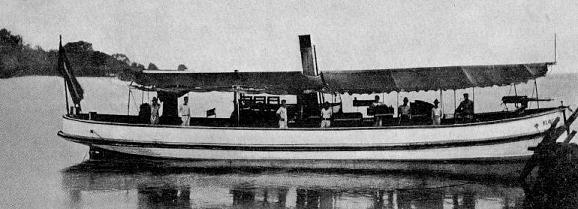
The gunboat Flake,
named after 2nd LT Campbell Flake of the 22nd Infantry, who was
killed
during the Ramaien expedition in January of 1904.
Photo from the Parker Hitt photograph collection, University of Michigan
According to the general plan, the field
battery was to have joined at this point to shell the main
cottas, about 900 and 1,500 yards distant;
but a reconnaissance showed that the nature of the country would
delay the battery's arrival some hours.
The nearest fort flew many war flags; from its
walls Moros brandished spears and krises; from loop-holes came a
desultory small arm fire.
The battalion's advance was necessarily slow; underbrush,
boulders, and a maze of stone walls obstructed the approach to
the cotta;
small parties of the enemy were driven from cover to cover until,
at about noon, the first cotta was charged and captured. A number
of lantacas
and iron cannon were found, the largest cannon firing a six inch
solid shot.
After a short rest, the advance was continued
toward the second stone cotta; this also flew war flags; in it
tom-toms were beating,
Moros were shouting taunts at the Americans.
It was impossible to approach this cotta except
in column of files. Before the battalion reached the cotta, the
battery arrived at the first position
captured early in the morning. The battalion was then recalled to
allow the battery to shell the stronghold. After this firing had
continued
for thirty minutes, the battalion again advanced and captured the
cotta without resistance. Very deadly and very accurate had been
the battery's work.
Shrapnel and fragments of shell were found all over the cotta;
blood in many places showed that many of these had found their
mark;
lantacas and cannon in position, loaded and aimed, and many
articles of personal property, showed the hasty abandonment of
the cotta.
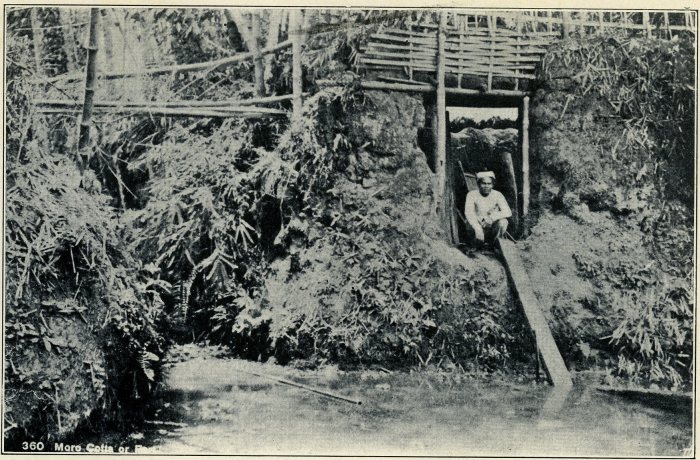
Moro cotta
Photo from the 1904 Regimental History
In this engagement, the battalion had one
officer and one enlisted man wounded.* The Moro loss was about
fifteen killed,
wounded not known. While the losses were not great, the object of
the expedition was accomplished. Through friendly Moros it was
learned
that the Sultan of Oato declared that he would not again oppose
American sovereignty.
* Wounded in action, Oct. 24, 1904:
Captain David L. Stone, company G
Private Peter Duquette, company E.
At the present time of publication of this
history ±, the regiment is stationed as follows:
Headquarters, companies B, C, E, F, G, H, I, and K, at Camp
Marahui.
Companies A and D, Marahui, Lake Lanao.
Companies L, and M, Camp Wheeler.
Provisional company, Fort Pikit.
The entire regiment is in active service.
± the Regimental History written in 1904
On November 24, 1904, Camp Wheeler, on the
Taraca River, was abandoned. Prior to the departure, however,
there came to the camp many of the Lanao chiefs to declare their
friendship; the Sultan of Bayabas himself brought three other
Sultans
to surrender with all their firearms and personal possessions.
The occupation ended, the result was clearly
apparent. An extensive, rich, and fertile river valley had been
opened to the tide of progress
and civilization, while among the natives themselves the
teachings of sound American principles of justice and freedom for
all had taken a firm root.
On December 27, 1904, request was made by
Daniel B. Devore, Civil Governor of the district, for an
expedition to put an end to an impending fight
between the Sultans of-Maciu and Oato, the former having stolen
three of the latter's wives. As a result of this request a force
of twenty men
of the Twenty-second Infantry, under Captain J. L. Donovan, was
despatched to the scene of trouble on the gunboat Flake.
Nothing ever came
of the expedition, however, there was no action, and the two
Sultans apparently settled their difficulties without any
extensive resort to arms.
On January 16, 1905, the name of the regiment's
station was changed from Camp Marahui to Camp Keithley.
The following month of February passed quietly for the regiment;
nothing of note or interest occurred until March 7, when Private
James Morrison,
of Company H, a sentinel on post, was stabbed to death by Moros.
As a result of this, Governor Devore, with Lieutenant Harry
Graham
and a detachment of forty men, proceeded to Ramaien, and thence
on the following day to Oato with 2nd Lieutenant Venable and
twenty men.
An expedition to apprehend the murderers of Morrison was
organized under Major Abner Pickering, 22nd Infantry, the force
consisting
of Companies E, H, I, and L, 22nd Infantry, and one section of
the 26th Battery of Field Artillery. On March 15 this expedition
embarked
on the gunboats Flake and Almonte, proceeding
to a point near the mouth of the Taraca River, where a landing
was effected.
Thence the troops marched to the Ragayan territory, where, in the
course of a brief skirmish, Private Patrick Burke, Company L, was
killed.
Four days later, March 19, a second expedition
to the Ragayan country, consisting of Companies A, B, C, D, F, G,
K, and M,
was placed under the command of Major J. J. Crittenden. The
results of the two expeditions were insignificant, no trace of
the murderers was found,
and the people of Ragayan were simply driven back into the hills.
The first part of April again found the regiment quiet, its only activity being the Department Athletic Meet at Jolo, which the Twenty-second won handily.
In May 1905 Private James H. Gilson, a musician
in the 22nd Infantry Regimental Band was awarded
a Certificate of Merit for actions he took on February 24, 1905.
The following is the citation for his Certificate:

The following extracts are from the Annual Reports to the Secretary of War, 1905:
( Red stars mark engagements in which
the 22nd Infantry took part
between August 1904 and May 1905. )
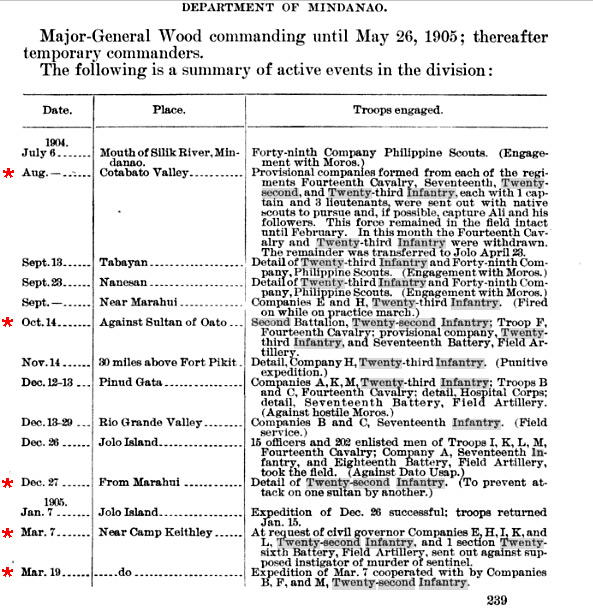

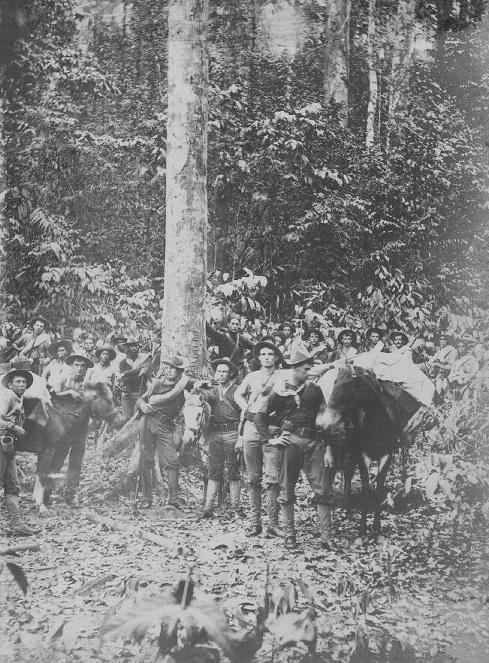
Soldiers of the 22nd Infantry
"somewhere" in the Philippines.
Several pack animals can be seen, and, in the left of the photo,
some cargadores,
native Filipinos hired to help with the hauling of supplies and
camp-making chores.
Soldier without hat to the right of the tree with his arm against tree is 1st Lieutenant Parker Hitt.
From the Parker Hitt photograph collection, University of Michigan
During the years 1904 and 1905
the following losses were incurred by the 22nd Infantry.
Places of birth are listed when known.
KIA = Killed In Action
DOW = Died Of Wounds
DOD = Died Of Disease
( A catch-all phrase used in the 19th Century to denote any
non-battle death)
Headquarters
John C. De Ginther.....06/25/1905 - Quartermaster Sergeant - KIA - Trenton, Arkansas - Killed by Moro at Camp Keithley, Marahui
Unassigned
Ezra Coder.....01/17/1905 - Private - DOD - Dedham, Iowa - Died of typhoid aboard transport Thomas enroute to join Regiment
Company A
Campbell Wallace
Flake.....01/22/1904 - 2nd Lieutenant - KIA - Greene County,
Georgia - Killed at Ramaien
Eary E. Sansoucie.....05/03/1905 - Private - KIA - Jefferson
County, Missouri - Killed near Ipil
Company B
Harry Parshall.....04/08/1904 -
2nd Lieutenant - DOD - Sauk County, Wisconsin - Died from Heart
Disease
Elick Howell.....05/03/1905 - Private - DOW - Floyd County,
Kentucky - Wounded in engagement near Ipil and died same day
Company C
Howard Glasgow.....05/03/1905 -
Private - DOW - Clermont County, Ohio - Wounded in engagement
near Ipil and died same day
John Anderson.....10/31/1905 - Private - DOD - Chicago, Illinois
- Died from Chronic Amoebic Dysentery Camp Keithley, Mindanao
Company D
Michael Deegan.....02/18/1904 -
Private DOD - Portland, Maine - (Discharged for disability
January 18, 1904 died one month later)
Charles P. Garst.....08/28/1904 - Private - DOD - Cloud County,
Kansas - Died from Typhoid
Company E
Anton M. Anderson.....04/09/1904 - Private - DOD - Decorah, Iowa - Drowned in Lake Lanao
Company F
David Porter
Wheeler.....04/14/1904 - Captain - DOW - Zanesville, Ohio -
Wounded 04/11/1904
Samuel G. Vicars.....01/28/1905 - Private - DOD - Knox County,
Kentucky - Died of Acute dysentery
Daniel Newport.....05/03/1905 - Corporal - KIA - Scott County,
Tennessee - Killed near Ipil
Company G
Charles E.
Ferguson.....02/03/1904 - Private - DOD - Cincinnati, Ohio -
Drowned BNR
Thomas F. Leahy.....02/04/1904 - Private DOD - acute acoholism
George Harrison.....05/04/1904 - Private - Montreal, Canada - DOD
Fitzgerald Swainson Turton.....08/29/1904 - 2nd Lieutenant - DOD
- New Zealand - Died at Marahui - suicide
Samuel Weaver.....05/01/1905 - Private - DOW - White County,
Tennessee - Near Ipil
Llewellyn W. Bobb.....10/22/1905 - Private - KIA - Richland
County, Wisconsin - Killed in the Cotabato Basin by Datu Ali
Company H
James Morrison.....03/07/1905 - KIA - Johnstown, New York - Killed by Moros while on sentry duty at Camp Keithley
Company I
Albert Collmen.....07/13/1904 -
Private - DOD - Hallen, Sweden - Died of Acute dysentery
Lucien McCandless.....02/11/1905 - Private - DOD - Kentucky -
Dysentery
Company K
Martin L. Bales.....10/22/1905 - Private - DOW - Annville, Kentucky - Wounded at Datu Ali cotta, Mindanao died same day
Company L
Patrick Burke.....03/16/1905 - Private - KIA - Columbus, Wisconsin - Killed in engagement at Ragayan, Mindanao
Company M
John J. Lynch.....11/01/1904 -
Private - DOD - Weston, Massachusetts - Drowned
William Witicka.....11/01/1904 - Private - DOD - Finland -
Drowned
Much of the above narrative taken from the 1904 and 1922 Regimental Histories
Additional material added by the website editor
Additional information taken from:
Returns from Regular Army Infantry
Regiments, June 1821–December 1916. NARA
microfilm publication M665
National Archives and Records Administration, Washington, D.C.
Register of Enlistments in the U.S. Army, 1798-1914; (National Archives Microfilm Publication M233
Home | Photos | Battles & History | Current |
Rosters & Reports | Medal of Honor | Killed
in Action |
Personnel Locator | Commanders | Station
List | Campaigns |
Honors | Insignia & Memorabilia | 4-42
Artillery | Taps |
What's New | Editorial | Links |